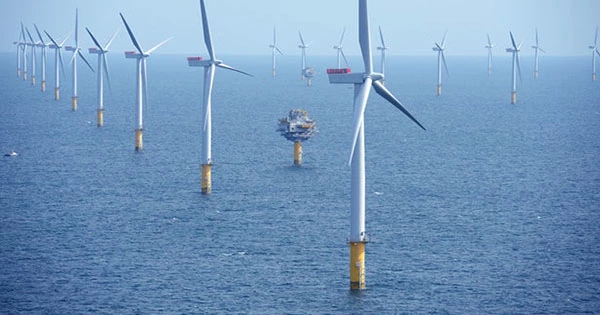A wind farm off the coast of the UK called Hornsea 2 is now fully operational and prepared to supply power to almost 1.3 million Britons. homes. It is officially the largest offshore wind farm in the world, with 165 turbines over an area of 462 square kilometers (approximately 178 square miles).
Patrick Harnett, the program director for the Hornsea 2 wind farm, told BBC News that “The UK is one of the world leaders in offshore wind.” The world’s largest offshore wind farm is now fully operational, which is incredibly exciting after five years of labor.
However, the new farm’s title as the biggest in the world will not last long. More than four times as many households as Hornsea 2 will eventually be able to power thanks to the Dogger Bank wind farm, which is scheduled to begin operating next year.
At a distance of roughly 89 kilometers (55 miles), Hornsea 2 is difficult to comprehend just how large these infants are. The 165 turbines are roughly the size of the Washington Monument in height and width, except that they rotate. Each of the 165 turbines rises 200 meters (656 feet) above the ocean, with each of its three blades being 81 meters (266 feet) across.
The statement signifies the end of a project that began supplying energy back in December 2021. According to reports, one UK home can be powered for 24 hours by a single blade spin. Since a rotation only lasts six seconds, each turbine can power more than 14,000 houses daily.
That’s good news for a number of reasons, the most obvious of which is the decreased reliance on fossil fuels. A factor of up to twenty reductions in carbon emissions is expected to be achieved by renewable energy sources during the next three decades, and wind power in particular offers a higher energy return on investment than, for example, coal. In comparison to coal, wind energy produces roughly 44 units of electricity for every unit of energy invested in it, compared to coal’s nine units.
For customers, Hornsea 2 is also welcome news. With a capacity of more than 1.3 gigawatts, wind power is one of the least expensive energy sources available as the globe deals with the present energy crisis. British energy bills are expected to increase by up to 80% next month.
According to Simon Evans of Carbon Brief, a website that tracks issues related to renewable energy, “the last time I checked it was about £450 per megawatt hour to buy power generated by gas,” he told the BBC. “That costs around nine times what it does now to construct new renewable capacity.”
At a time when sanctions against Russia are restricting Europe’s access to gas, Hornsea 2’s launch is fortunate. More than 96 percent of the UK’s gas comes from sources other than Russia, making it one of the fortunate countries on the continent. Nevertheless, the UK is still susceptible to fluctuations in the global gas market, which is another reason to wean itself off of fossil fuels.
According to Duncan Clark, head of the U.K., “current global events underline more than ever the necessity of landmark renewable energy projects like Hornsea 2.” The region at rested, the farm’s owner, spoke with CNBC. By lowering reliance on pricey fossil fuels, the new farm would “[help] the UK strengthen the security and stability of its energy supply and bring down costs for consumers.”














